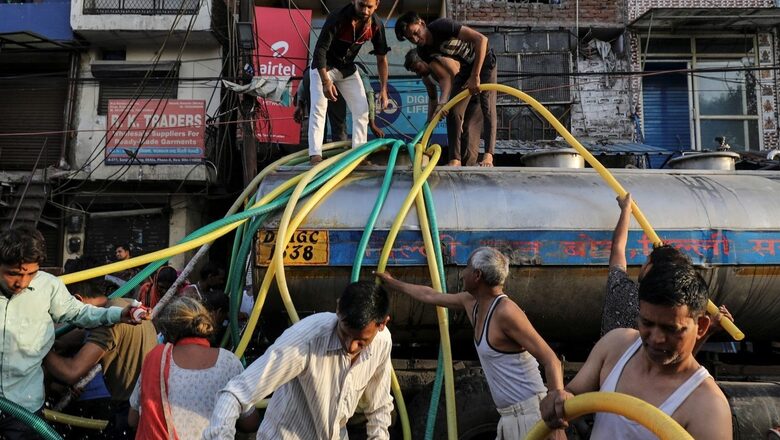
views
As the heatwave condition has intensified in various parts of the country, the Arvind Kejriwal-led Delhi government on Thursday announced to supply around 1,000 million gallons of drinking water every day during the peak summer season (April-July). Earlier, the Delhi Jal Board (DJB) supplied 935 MGD of potable water to the city residents on average. The DJB shared its Summer Action Plan and said that a total of 1,198 water tankers enabled with GPS for transparency will be deployed across the national capital to prevent water shortage.
After the hottest March on record, a large part of the country continue to experience extreme heat in April, sending power and water demand to an all-time high. The heatwave is predicted to turn deadlier in the coming days.
“To meet the water requirement of the city residents, especially considering the rising heat this year, the Delhi government is targeting to supply about 1,000 MGD of potable water during the summer of 2022 by optimizing all the resources,” a statement quoted by Delhi Water Minister Satyendar Jain as saying.
“The system has been made efficient and robust so that there is no water scarcity during the summer season. The water minister is personally monitoring the situation,” the statement said, adding that the AAP-led Delhi government is also keeping an eye on the level of ammonia in the raw water released from Haryana so that it does not impede the water supply in the city.
All the jhuggi-jhopri clusters in Delhi avail the facility of public hydrants and water tankers. Additional water tankers will be provided if there is a scarcity of water, Jain said, adding that depending on the requirement during peak summer, the trips of the tankers will be optimized to supplement the demand in the water-deficient areas and regions lacking piped water supply.
The DJB has equipped the tankers with GPS systems to track their movement. It will bring in more transparency and improve the service quality, Jain said.
He also informed that the DJB has also replaced old pipelines and fixed leakages to minimize water loss and contamination. Area-wise timings for water supply will be made available on the DJB website.
The board said that the emergency control rooms have been provided with adequate staff, communication facilities, and better equipment for grievance redressal and monitoring.
IMD Prediction
An intense heatwave broiled Delhi on Thursday, with the Safdarjung observatory recording a maximum temperature of 43.5 degrees Celsius, the highest in April in 12 years. The national capital had recorded a maximum temperature of 43.7 degrees Celsius on April 18, 2010. The all-time high temperature for the month was 45.6 degrees Celsius recorded on April 29, 1941.
The mercury leaped to 46 degrees Celsius at Sports Complex, making it the warmest place in the capital. Ridge (45.1 degrees Celsius), Mungeshpur (45.8 degrees Celsius), Najafgarh (45.4 degrees Celsius) and Pitampura (45.2 degrees Celsius) recorded the maximum temperature at least five notches above normal.
The mercury at the Safdarjung observatory — Delhi's base station — is expected to touch 44 degrees Celsius by Friday, according to the India Meteorological Department (IMD). The maximum temperature may even leap to 46 degrees Celsius in parts of Delhi, an IMD official said.
Delhi may also see a partly cloudy sky, light rain, and a dust storm with winds gusting up to 50 kmph on Friday and Sunday, which may provide a temporary respite.
The city has recorded eight heatwave days in April this year, the maximum since 11 such days witnessed in the month in 2010.
Delhi falls in the Core Heatwave Zone (CHZ), comprising the most heatwave-prone areas of the country, along with Telangana, Andhra Pradesh, Himachal Pradesh, Uttarakhand, Haryana, Uttar Pradesh, Rajasthan, Madhya Pradesh, Maharashtra, Bihar, Chhattisgarh, and West Bengal.
The IMD said the heatwave could lead to “moderate” health concerns for vulnerable people — infants, the elderly, people with chronic diseases — in affected areas. “Hence, people of these regions should avoid heat exposure, wear lightweight, light-colored, loose, cotton clothes and cover the head by use of cloth, hat or umbrella, etc,” it said.
For the plains, a heatwave is declared when the maximum temperature is over 40 degrees Celsius and at least 4.5 notches above normal. A severe heatwave is declared if the departure from normal temperature is more than 6.4 notches, according to the IMD.
Based on absolute recorded temperatures, a heatwave is declared when an area logs a maximum temperature of 45 degrees Celsius. A severe heatwave is declared if the temperature crosses the 47-degree mark. The weather department had earlier said that northwest India and adjoining parts of central India are likely to see more intense and frequent heatwave conditions in April.
(with inputs from PTI)
Read all the Latest India News here



















Comments
0 comment